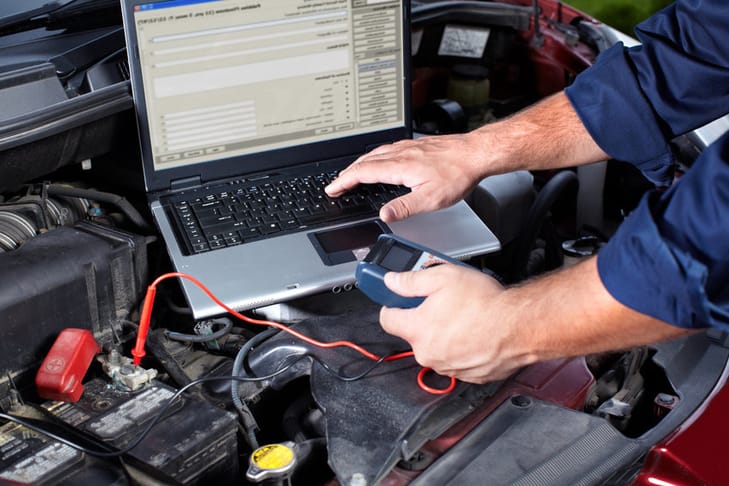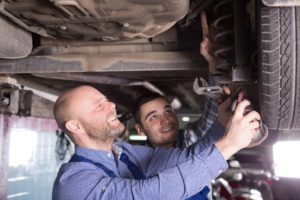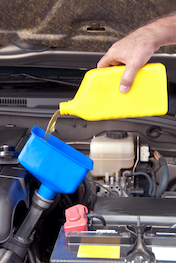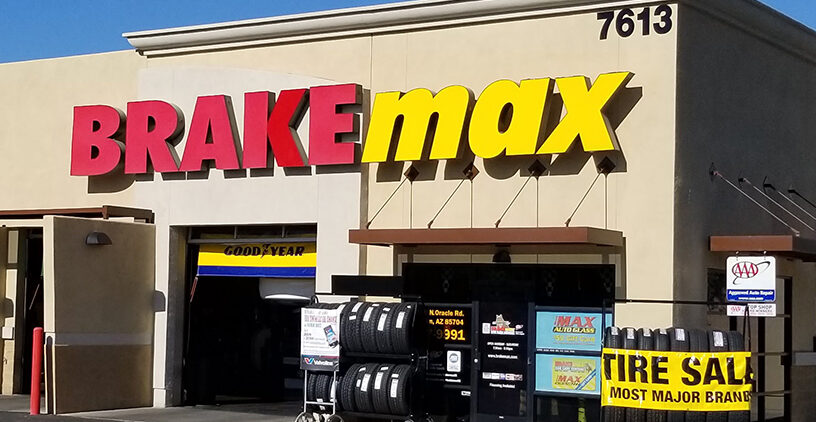Tucson Auto Repair and Maintenance Guide

Your vehicle is made up of dozens of different components that all help multiple different systems run simultaneously. Every time you get in the car, you rely on these components to operate as expected and get you to your destination.
But they don’t last forever. You will occasionally run into a situation where you need auto repair services done. Of course, preventative maintenance will help extend the life of your vehicle’s systems and prevent the need for costly car repairs down the road.
Having a basic knowledge of auto repair and maintenance can help you confidently take care of your vehicle, ensure you have reliable transportation, and keep you from being at the auto repair shop more than you need to be.
In this guide, we cover what you need to know about common auto repairs and how to partner with your trusted auto mechanic to keep your vehicle in top shape.
The Most Common Auto Repair Services in Tucson
As your vehicle is driven, wear and tear will be put on the main systems that keep it running and keep you comfortable on the road. This includes the engine, transmission system, fuel system, electrical system, brake system, and suspension system. So the most common auto repair needs that you may encounter will usually involve components within these systems.
The most common car repair needs that an auto mechanic will see daily include:
- Brake Repair
- Tire repair or replacement
- Battery service or replacement
- Coolant system repair
- Suspension system repair
- Air filter replacement
- Spark plug replacement
- Head gasket repair
How to Identify Specific Problems That Need Service
At this point, you may be wondering what the need for those common repairs may look or feel like when it comes to your vehicle. There are some specific warning signs to be aware of. Knowing what to look out for will help ensure you get an issue addressed with your car mechanic quickly before it has the chance to become a larger problem.
Using your senses is actually a very good way to pick up on some common auto problems:
Feel
If your vehicle feels different while driving, it will usually be one of the first things you notice. Some things you may feel that indicate you may need auto repair include:
- Difficulty starting the engine, engine stalling, or rougher idling: Often caused by an engine issue within the starting system, charging system, or fuel system.
- Lack of acceleration: Can be caused by a clogged air filter, dirty fuel filter, overly worn spark plugs, or bad O2 sensor.
- Unusual vibration in the steering wheel or seat: Usually caused by an unbalanced tire or worn parts in the steering/suspension system.
- The vehicle is pulling to one side: This can be the result of the front end being out of alignment, an underinflated tire, a brake issue, or overly worn steering components.
- Different feel in the brake pedal: A sinking or spongy feeling brake pedal usually indicates reduced braking power caused by a brake problem.
- Rough shifting or a failure to shift during acceleration: Usually caused by a failing transmission system component.
Sound
Strange or unusual sounds are common indicators that an issue may be present and should be inspected including:
- High-pitched shrieking while braking or while the vehicle is moving: Usually caused by the brake wear indicators when brake service is overdue.
- Sharp, loud squealing: This can be from a worn air-conditioning belt, faulty fan, or overly worn power steering.
- A sharp clicking sound that increases with vehicle speed: Often due to low engine oil, a loose or bent fan blade, or a stuck valve lifter.
- Occasional clunking: This can be due to a loose suspension component or loose exhaust pipe.
- Unusual low and/or rhythmic rumble: Usually due to a defective exhaust pipe, a bad muffler, or a bad universal joint.
Smell
Several common auto issues can be detected by a distinct smell including:
- Strong burnt toast smell: This can mean that insulation is burning and/or there is an electrical short. Do not continue to drive the vehicle if this happens.
- Bitter burnt odor: Often means that an oil change is greatly overdue, or the vehicle is leaking oil.
- Continuous rotten eggs smell: Usually caused by a problem with the catalytic converter or another emission control component.
- Sweet, maple syrup smell: Often caused by a coolant leak. Watch the temperature gauge on your instrument panel, and if the engine starts to overheat, do not continue to drive.
- Strong burnt chemical smell: Usually caused by overheated brakes or clutch. If light smoke is coming from one of your wheels, then the brake is locked up, and you should have the vehicle towed in for repair.
Sight
Of course, a clear indication that there is a problem is if you see your Check Engine light illuminated on the dashboard. But you should also get in the habit of regularly looking under your vehicle for any visible fluid leaks.
Different color fluids will mean different possible issues including:
- Bright yellowish-green, light pastel blue, or watery fluorescent orange fluid: Usually indicates a coolant or antifreeze leak from a bad hose, leaking radiator, or faulty water pump.
- Greasy dark brown or black fluid: Most often caused by a motor oil leak from a bad gasket or seal.
- Oily red fluid: This usually comes from a leak in the power steering or transmission system.
You know better than anyone how your vehicle usually drives. So, if any of the above are happening or if something else seems different, bring your vehicle in to be inspected at your closest Tucson auto shop.

Why Preventative Vehicle Maintenance is So Important
Proper preventative vehicle maintenance is critical to ensuring you always have a safe and reliable means of transportation. Keeping up with the manufacturer’s suggested service schedule is the easiest way to help keep your vehicle running in optimal working order. This includes regular oil changes, brake inspections and services, system fluid level checks, tire maintenance services, etc.
It may seem like a bigger investment in time and money upfront, but doing so will prevent bigger and more costly problems down the road, ones that will surely keep you off the road for much longer. Plus, not following the manufacturer’s preventative maintenance guidelines can even void your vehicle’s warranty.
Also, when it comes time to trade in or sell your vehicle, keeping up with maintenance and having detailed service records can boost the value.
How Often to Bring Your Vehicle In for Maintenance and Repair
The first place to look when it comes to determining exactly when to come in for an inspection and service is your vehicle’s owner’s manual. This will give the exact recommended schedule for your particular vehicle.
In Arizona, it is required that your vehicle passes an annual emissions inspection. So, at the very least, your vehicle needs to be inspected and serviced on an annual basis. But to keep it running optimally, you should follow the manufacturer’s service schedule for all the critical systems.
When you have your vehicle’s oil changed at an auto repair and service shop, like BRAKEmax Tire & Service Centers, the technician will also do a multi-point vehicle inspection to check filters, fluid levels, and other components, as well as a tire rotation (if requested). As auto technology has evolved over the last several decades, the rule of thumb changed from an oil change every 3,000 miles to now closer to 5,000 miles or more, depending on the type of oil.
In addition to regular oil changes and tire rotations, manufacturers usually also recommend inspection and replacement of certain parts when the vehicle hits 30,000 miles, 60,000 miles, and 90,000 miles. Again, make sure to refer to your owner’s manual for your vehicle’s specific maintenance schedule.
Tucson Auto Repair and Maintenance Checklist
As mentioned above, following a regular routine of preventative maintenance will maximize the performance and lifespan of your vehicle. Having an idea of what needs to happen when will help you stay on schedule and keep things in proper working order.
In general, you can use the following schedule as a starting point:
Immediately
- Check Engine light: When the vehicle’s computerized control system discovers a problem, this light will be illuminated. When you see this light, bring your vehicle to your closest auto repair shop as soon as you can. An experienced auto mechanic will run a diagnostic test to pinpoint the exact problem.
- Low tire-pressure light: When one of your tire’s air pressure drops below the minimum amount, the tire-pressure monitoring system will alert you. Driving with low tire pressure can be dangerous, so make sure to inflate your tires to proper levels as needed as soon as possible.
- Headlight or taillight out: If one of these important lights has gone out, check the bulb and check for a blown fuse. Make sure to have this fixed as soon as you can to avoid unsafe driving conditions or even a traffic ticket.
Monthly
- Brake lights, turn signals, fog lights, and parking lights: You will usually notice quickly when a headlight is not working. But your vehicle’s other lights are not as obvious. So, make sure to visually inspect all the lights monthly to ensure they are working.
- Tire pressure and tread depth: To ensure safe driving, your tires need to be at proper air pressure and in good condition. So you should regularly inspect your tires’ air pressure and tread depth, as well as check for uneven wear.
- Coolant and levels: When the engine is cool, check these fluid levels at least once a month. Make sure to top off the levels as needed before taking a long trip.
- Windshield wiper fluid: A dirty windshield can significantly obstruct your view and cause an unsafe driving situation. Check monthly to make sure the wiper fluid reservoir has an adequate amount of fluid.
Every Three Months
- Oil and filters: Engines that are using conventional motor oil will usually need an oil and oil filter change every three months or 3,000 miles. Semi-synthetic varieties can often go for about
 5,000 miles. Engines using synthetic oil will usually only need an oil and filter change every 7,000 to 10,000 miles. Your engine’s air filter should also be checked and replaced during your oil change if needed.
5,000 miles. Engines using synthetic oil will usually only need an oil and filter change every 7,000 to 10,000 miles. Your engine’s air filter should also be checked and replaced during your oil change if needed. - Rotate tires: Regularly having your tires rotated will help extend their life by balancing the tread wear. So, a good habit to get into is to have them rotated roughly every three months (or when you have your oil changed).
- Battery and battery cables: Check to make sure that there is no corrosion or leaking fluid on the battery. Also, make sure the battery cables are tightly connected and not overly worn.
- Power steering fluid:<span style=”font-weight: 400;”> When the engine is warm, check the power steering fluid level and add more as needed.
- Belts and hoses: The belts and hoses within your engine play an important role in keeping systems functioning. Make sure that belts are not cracked or frayed and that hoses are not bulging, cracked, or leaking.
- Windshield wiper blades: Overly worn wiper blades can quickly create a safety hazard when it rains due to decreased visibility. Inspect the blades and replace them if they are no longer properly clearing the windshield or are damaged.
Every Six Months
- Battery performance check: Car batteries usually last between three and five years. So, when your battery reaches three years old, make sure to have it tested twice a year.
- Exhaust system: Inspect the system and have any damage repaired, especially if there is excessive noise coming from the muffler.
- Chassis lubrication: Check your owner’s manual to see if your vehicle’s chassis, suspension, and steering systems need periodic lubrication.
Once a Year
- Cabin air filter: Your cabin air filter helps keep the air inside the car clean and should be replaced annually.
- Brakes: The brake fluid, brake linings, brake pads, and rotors should all be inspected to help ensure proper and safe operation. Overly worn parts should be replaced as soon as possible.
- Shocks and struts: Shocks and struts are critical to your vehicle’s steering system and should be inspected annually. If you notice a rougher ride when driving, bring your vehicle in as soon as possible.
- Coolant/antifreeze: After 60,000 miles, the entire cooling system should be flushed, and the coolant replaced once a year.
Every Two Years
- Ignition system: High-quality spark plugs, wires, coils, and other electrical components can often last 100,000 miles. But it is still a good idea to have spark plugs checked once you reach 30,000 miles.
- Transmission fluid: In a manual transmission vehicle, the transmission fluid should be changed between 30,000 and 60,000 miles, depending on the vehicle. With an automatic transmission, the fluid should be changed between 30,000 and 100,000 miles. As mentioned above, regularly check the transmission fluid level and top it off when needed.
- Fuel filter: Some manufacturers suggest fuel filter replacement at 30,000 miles. Check your owner’s manual for the specific recommendation for your vehicle.
Long-Term
- Front and rear differential: These devices send power to the tires to propel the car by splitting the torque from the engine. Your vehicle’s differentials require lubrication and should be checked according to manufacturer recommendations.
- Replace tires: Tires can often last between three and six years. Once your tire’s tread reaches 2/32 of an inch or less, make sure to replace them to ensure your vehicle’s performance and safety on the road.
- Battery: Begin testing your battery at the three-year mark and replace it at five years.
- Timing belt: Many manufacturers recommend replacing the timing belt between 60,000 and 90,000 miles. Keep in mind that not all vehicles have timing belts. Those that have a timing chain often do not need periodic maintenance (or replacement) unless there’s a problem.
- Transfer case fluid: In 4-wheel-drive and all-wheel-drive vehicles, the transfer case shifts power from the transmission to the axles. Have the fluid checked according to manufacturer recommendations.
These auto maintenance milestones are general guidelines. Make sure to carefully follow your vehicle manufacturer’s recommendations for optimal preventative maintenance intervals.
Trust the Experts at BRAKEmax When You Need Auto Repair in Tucson
The most important thing to remember is that as soon as you notice something unusual about the way your vehicle is driving, do not ignore it. Bring your vehicle to your closest Tucson auto service shop as soon as possible to prevent a potentially small issue from turning into an expensive problem. But keeping up with regular vehicle maintenance will help reduce the chance of problems happening and keep things running optimally for longer.
When you need auto repair and maintenance experts, you can trust the ASE-certified experts at BRAKEmax Tire & Service Centers for all your car, truck, or SUV needs. Since 1997, Tucson area drivers have been relying on our technicians for professional vehicle maintenance, reliable auto repairs, and the best customer service experience around, all at affordable prices that cannot be beat.









